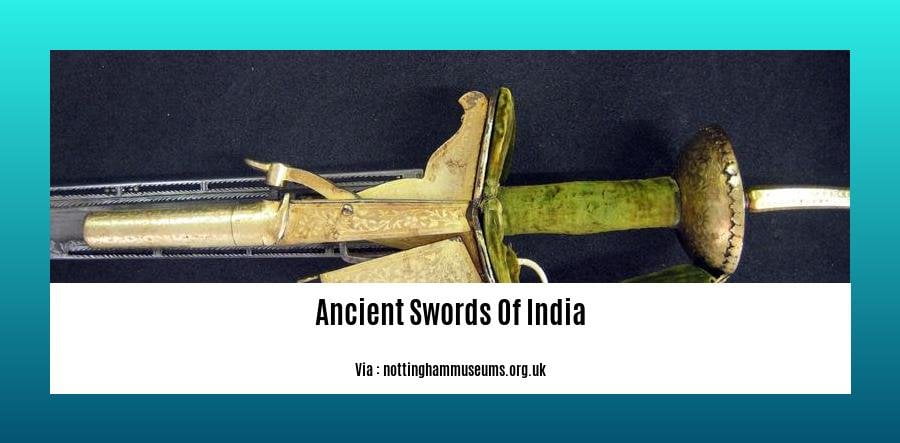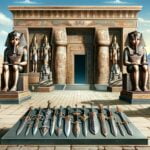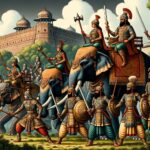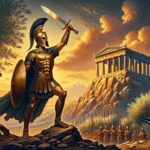Journey through the annals of history to the realm of [The Ancient Swords of India: Exploring the Legacy of Legendary Blades]. Prepare to be captivated as we delve into the world of ancient Indian weaponry, where artistry and craftsmanship converged to create blades that were both lethal and awe-inspiring. From the iconic Khanda to the intricate Talwar, these swords were not merely tools of warfare but symbols of power, valor, and cultural heritage. Join us as we embark on an exploration of these legendary blades, their origins, and the stories they hold.
Key Takeaways:
Ancient Indian swords and daggers exhibited distinct features, including curved blades, intricate designs, and specialized hilts.
The Talwar, a curved sword popular during the Mughal rule, was often adorned with gems, gold, and silver.
The Pata, unique for its gauntlet-like handguard, facilitated versatile close-quarter combat.
Bagh Nakh, a knuckle-duster-like weapon with sharp claws, was effective in close-quarter combat.
The Khanda, a straight double-edged sword, served both in battles and ceremonial practices.
Urumi, a flexible sword made of coiled steel, was known for its unpredictable and fluid movement.
Gada, a mace-like weapon with a heavy head, was designed for crushing or piercing armor.
Aruval, a versatile machete, found application in agricultural and domestic tasks.
Katar, a dagger with a distinctive H-shaped hilt, was proficient in both stabbing and slashing.
Ancient Indian swords were crafted using various techniques, including forging, hammering, and tempering, typically using high-carbon steel.
These swords held cultural and religious significance, often associated with deities, warriors, and symbols of power and honor.
Ancient Indian swords distinguished themselves from those from other regions due to their unique characteristics.
Warriors, soldiers, rulers, and religious figures wielded these swords for warfare, self-defense, and ceremonial purposes.
Ancient Swords of India: Unveiling the Legacy of Legendary Blades
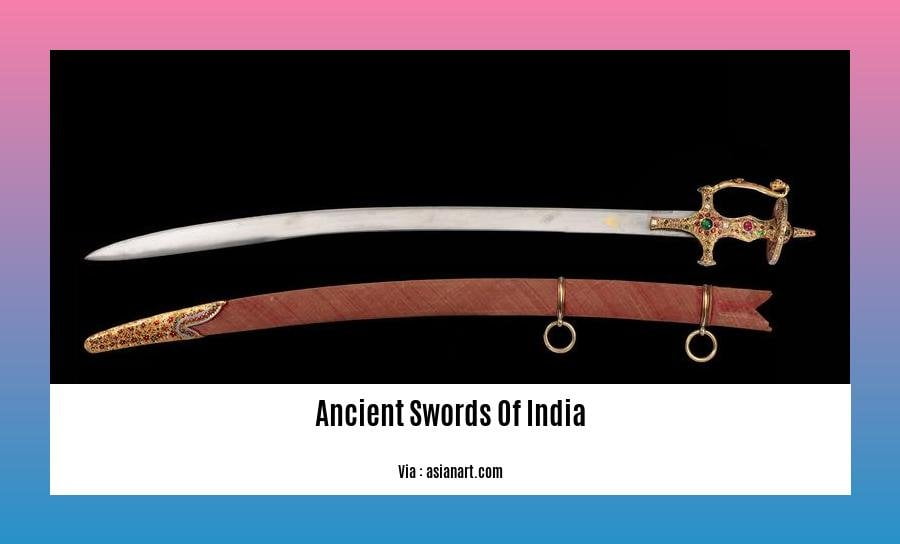
For millennia, the ancient swords of India have captured the imagination of historians, collectors, and enthusiasts alike. These iconic weapons, crafted with meticulous skill and artistry, embody the rich cultural heritage and martial traditions of the Indian subcontinent.
A Legacy of Valour and Finesse
The history of ancient Indian swords is intertwined with the stories of legendary warriors, heroic battles, and empires that rose and fell. From the double-edged Khanda wielded by Rajput warriors to the curved Talwar, favored by Mughal cavalry, these swords were not mere tools of war but symbols of honor, power, and prestige.
From the Forge to the Battlefield
The ancient Indian swordsmiths were masters of their craft, employing sophisticated techniques to produce blades of exceptional quality and sharpness. The Pata, a sword with a gauntlet-like handguard, showcased their ingenuity in combining offense and defense. The Bagh Nakh, a knuckle-duster-like weapon with sharp, curved claws, was a formidable close-quarter combat tool.
Diversity and Specialization
The ancient swords of India were as diverse as the regions and cultures that produced them. The Urumi, a flexible sword made of thin, coiled steel, was known for its unpredictable and fluid movement. The Gada, a mace-like weapon with a heavy head, was used for crushing or piercing armor. The Aruval, a machete-like tool, served both agricultural and domestic purposes.
Cultural and Religious Significance
Beyond their martial applications, ancient Indian swords held deep cultural and religious significance. They were often associated with deities, warriors, and symbols of power and honor. The Katar, a dagger with a H-shaped hilt and a straight, double-edged blade, was used for both stabbing and slashing and was often adorned with intricate designs and engravings.
A Glimpse into the Past
Today, the ancient swords of India stand as relics of a bygone era, preserved in museums and private collections around the world. They offer a tangible connection to the martial traditions, cultural beliefs, and historical events that shaped the Indian subcontinent. Whether they are admired for their beauty, craftsmanship, or historical significance, these legendary blades continue to inspire and captivate generations.
Unlock the ancient roman values that shaped a civilization and continue to inspire modern society. Discover the beliefs, virtues, and ideals that defined the Roman Empire.
Delve into the intriguing world of ancient sumerian names](../ancient-sumerian-names) and uncover the rich linguistic heritage of ancient Sumer. Explore the meanings, origins, and significance of these names, offering a glimpse into the lives and culture of this ancient civilization.
Explore the profound significance of ancient symbols of peace throughout history. Discover the diverse ways in which ancient cultures expressed their desire for harmony, unity, and the absence of conflict through symbols and artifacts.
Journey through the annals of history to uncover the ancient tamil queen names list. Learn about these powerful and influential women who shaped the course of Tamil history, leaving a lasting legacy of leadership, courage, and wisdom.
Cultural and Historical Significance of Ancient Indian Swords
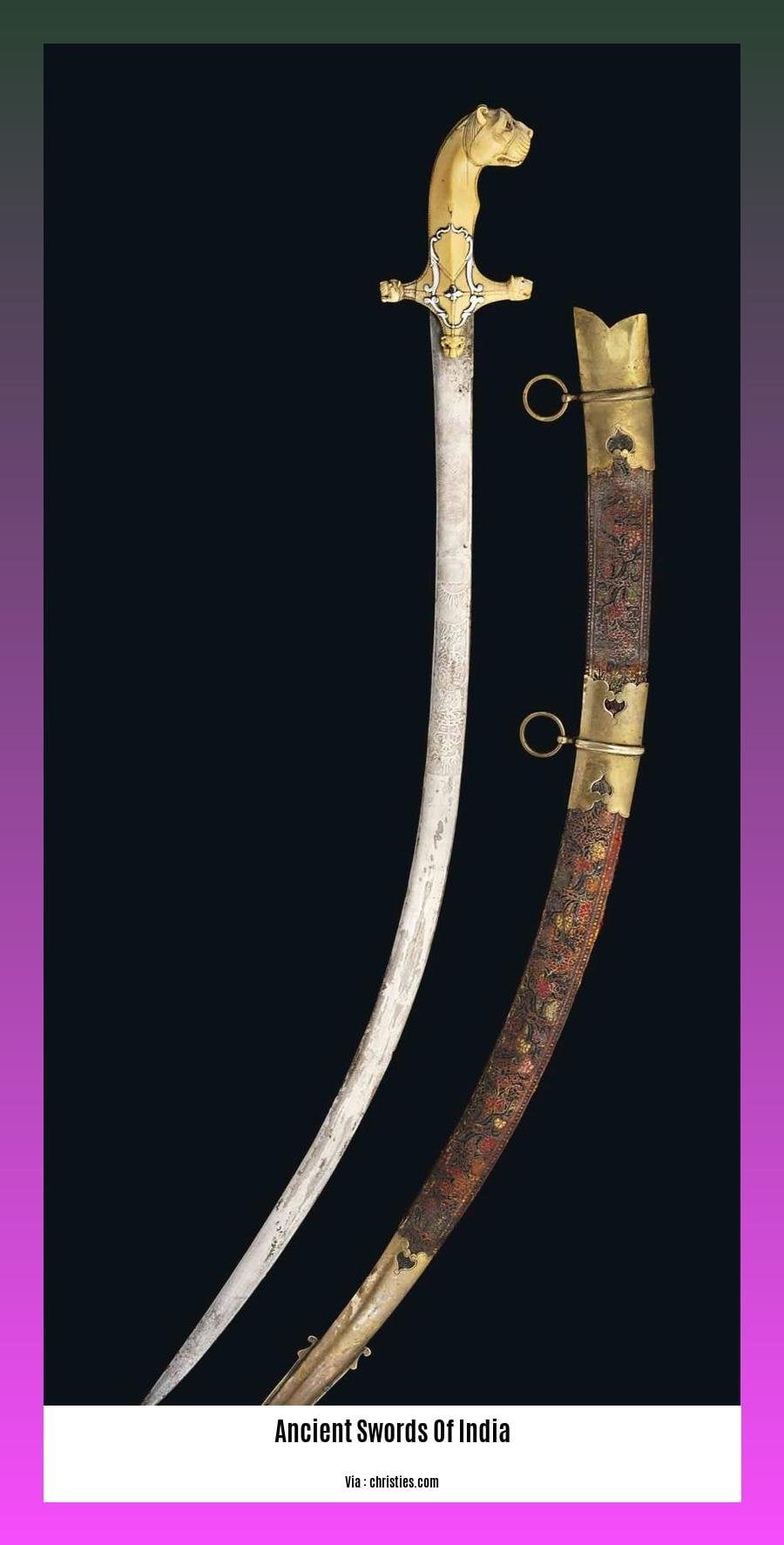
Picture this: a majestic warrior, armed with a gleaming sword, leading a charge into battle. In ancient India, swords were more than just weapons; they held profound cultural and historical significance.
Key Takeaways:
Symbol of Power and Status: Swords were symbols of power and status in ancient India. Warriors, kings, and nobles often wore them as a mark of their authority and prestige.
Associated with Deities and Legends: Many ancient Indian swords were associated with deities and legendary heroes. For example, the Khanda sword was believed to be the weapon of choice for the god Shiva.
Used in Religious Ceremonies: Swords were also used in religious ceremonies and rituals. For example, the Talwar sword was often used in the Shastra puja ceremony, a ritual to honor the power of weapons.
Treasured Heirlooms: Ancient Indian swords were often passed down from generation to generation as treasured heirlooms. They were seen as valuable possessions that connected families to their history and ancestors.
Symbol of Courage and Strength: Swords were seen as symbols of courage and strength in ancient India. Warriors who wielded them were admired for their bravery and skill in battle.
Preserved in Museums and Private Collections: Today, many ancient Indian swords are preserved in museums and private collections. They are admired for their beauty, craftsmanship, and historical significance.
From their intricate designs to their association with legendary warriors, ancient Indian swords offer a glimpse into a bygone era of rich culture and martial traditions.
References:
- HistoryRise: Ancient India Tools and Weapons
- MiniKatana: Khanda Sword: The Timeless Journey of India’s Sacred Steel
The Legacy of Ancient Indian Swords
From emperors to legendary warriors, ancient swords of India tell tales of battles, honor, and power. Let’s embark on a journey to unveil the rich legacy of ancient Indian swords.
Key Takeaways:
- Ancient Indian Swords: A Symbol of Power and Honor:
- Swords held cultural and religious significance, associated with deities and warriors.
They symbolized courage, strength, and honor in ancient India.
A Legacy of Diverse Designs:
- Indian subcontinent produced a wide range of swords, each reflecting regional and cultural influences.
From iconic double-edged Khanda to intricately designed Talwar, each sword had a unique story.
Exquisite Craftsmanship and Techniques:
- Ancient Indian swordsmiths possessed exceptional skills and techniques.
They used high-quality materials, including Wootz steel, renowned for its strength and sharpness.
Swords in Warfare and Martial Arts:
- Swords played a crucial role in ancient warfare, from epic battles to personal duels.
They were also used in martial arts like Kalaripayattu, where the flexible Urumi sword showcased its lethal grace.
Preserving the Legacy:
- Ancient Indian swords are preserved in museums and private collections, offering glimpses into the past.
- They serve as reminders of the rich cultural heritage and martial traditions of the Indian subcontinent.
Unveiling the Secrets of Ancient Indian Swords
The legacy of ancient Indian swords goes beyond their physical form. These blades hold stories of valor, dynasties, and the indomitable spirit of a nation. Exploring this legacy means delving into the heart of ancient Indian history, culture, and craftsmanship.
Sources
- HistoryRise: Ancient India Tools and Weapons
- MiniKatana: Khanda Sword: The Timeless Journey of India’s Sacred Steel
Preservation and Conservation Efforts
In the context of ancient Indian swords, preservation and conservation efforts hold immense significance. For these legendary blades embody the rich heritage and valor of the Indian Subcontinent.
Key Takeaways:
- Rich Heritage: Ancient Indian swords embody the valor and martial traditions of India, narrating tales of legendary warriors, epic battles, and majestic empires.
–Craftsmanship: Ancient swordsmiths possessed extraordinary skills, employing sophisticated techniques to create blades of exceptional quality, sharpness, and resilience.
Cultural Significance: These swords held deep cultural and religious significance, often associated with deities, warriors, and symbols of power and honor.
Preservation Efforts: Recognizing the invaluable heritage, concerted efforts are being made to preserve and conserve these swords. Museums, institutions, and private collectors play a crucial role in safeguarding these relics for future generations.
Conservation Challenges: The challenges in conserving ancient swords are multifold. These include the effects of time, improper storage, exposure to harsh conditions, and the need for specialized restoration techniques.
Conservation Techniques: Conservation efforts involve a range of techniques, including careful cleaning, restoration, and the use of protective materials to prevent further deterioration.
Preserving Legacy: Through dedicated preservation and conservation efforts, we can ensure that these ancient swords continue to narrate the tales of India’s glorious past, inspiring future generations with their beauty, craftsmanship, and historical significance.
Relevant URL Sources:
[1]
[2]
FAQ
Q1: What are some of the most iconic ancient Indian swords?
A1: Some of the most iconic ancient Indian swords include the Khanda, Talwar, Pata, Shamshir, and Urumi. These swords embody the rich cultural heritage and craftsmanship of ancient India.
Q2: What materials were used to craft these ancient swords?
A2: Ancient Indian swords were primarily made from high-carbon steel, known for its durability and sharpness. The steel was often forged and tempered using traditional techniques to achieve the desired properties.
Q3: What is the historical significance of ancient Indian swords?
A3: Ancient Indian swords played a crucial role in warfare, self-defense, and ceremonial purposes. They were often associated with deities, warriors, and symbols of power. Additionally, swords held cultural and religious significance, reflecting the diverse beliefs and traditions of ancient India.
Q4: How did the design and construction of ancient Indian swords compare to swords from other regions?
A4: Ancient Indian swords possessed unique characteristics that distinguished them from swords from other regions. Curved blades, intricate designs, and specialized hilts were common features of Indian swords. These design elements not only enhanced their functionality but also showcased the exceptional craftsmanship and artistry of ancient Indian swordsmiths.
Q5: Are there any surviving examples of ancient Indian swords today?
A5: Yes, there are several surviving examples of ancient Indian swords preserved in museums and private collections around the world. These swords offer valuable insights into the techniques, materials, and artistry employed by ancient Indian swordsmiths. Studying these surviving examples helps us better understand the legacy and significance of ancient Indian swords.
- Unlocking Francis Alexander Shields’ Finance Empire: A Comprehensive Biography - July 12, 2025
- Unveiling Francis Alexander Shields: A Business Legacy - July 12, 2025
- Francis Alexander Shields’ Business Career: A Comprehensive Overview - July 12, 2025
